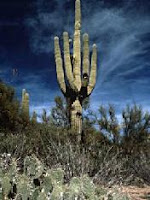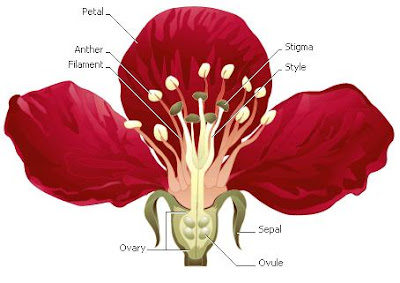Pictures of Angiosperms
 Saguaro Cactus
Saguaro CactusThe saguaro cactus, common in Arizona’s desert areas, branches only after it has reached a height of about 5 m (about 15 ft). The saguaro grows very slowly, approximately 2.5 cm (approximately 1 in) per year, and can reach heights of up to about 15 m (about 50 ft). Featured on a United States postage stamp in 1962, the plant’s waxy white blossom is Arizona’s state flower.
 Sausage Tree
Sausage TreeThe sausage tree, native to Africa, is named for its unusual sausagelike fruits. The woody capsules can be up to 60 cm (24 in) long, 10 cm (4 in) wide, and weigh up to 5 kg (12 lb). The fruit takes a year to ripen and is inedible, but is often used in folk remedies for skin conditions.
 Scarlet Runner Bean
Scarlet Runner BeanBeans, like this scarlet runner bean, are cultivated throughout the world. Symbiotic nitrogen-fixing bacteria, present in small nodules on the roots of beans and other legumes, help to return nitrogen to the soil, where the plant can then utilize it directly. In exchange, the bacteria in the root nodules use organic compounds supplied by the plant as an energy source.
 Silk Oak
Silk OakA native of eastern Australia, the silk oak has been introduced to tropical and subtropical areas worldwide. The dark green or bronze leaves are covered with white, silky hairs on the underside. The yellow-orange flowers attract bees and provide nectar for honey production in some regions. The silk oak is also used as a shade tree, a street tree, and even a potted ornamental.
 Silver Birch
Silver BirchThe silver birch tree, one of a number of birches native to parts of South America and to temperate and arctic regions of the northern hemisphere, is a deciduous tree growing to a height of 30 m (70 ft). This birch has silver-white bark that slowly turns black at the base of the trunk in older plants. Its leaves turn a bright yellow in autumn.
 Skullcap
Skullcap Resembling a knight’s helmet with the visor up, the distinctive skullcap flowers are prized in rock gardens. These wildflowers are distributed in woods, grasslands, and meadows throughout the world and spread rapidly via underground stems called rhizomes.
 Snapdragon
SnapdragonThis garden variety of the snapdragon plant flowers in Skylands State Park, New Jersey. When the flower’s petals, said to resemble the mouth of a dragon, are pulled apart and released, they close with an audible snap—hence the plant’s name. Horticulturalists have developed many strains of snapdragons with varying colors and fragrance for ornamental use.
 Soapwort
SoapwortA fast-spreading, hardy plant with distinctive flowers, soapwort contains a compound known as saponin that can lather up in water like soap. Although saponin soaps were replaced in the 1800s by fat-based soaps, the mild solution from soapwort is still used by dyers who work with delicate fabrics and as an ingredient in herbal shampoos.
 Spanish Moss
Spanish MossAn epiphyte (air plant), Spanish moss does not root in soil, but instead attaches itself to trees. The plant hangs from the limbs and trunks of oak trees in South America and the southeastern United States. As with other epiphytes, Spanish moss utilizes a unique structural design to absorb water directly from the air and to secure nutrients from drifting dust particles.
 Stinging Nettle
Stinging NettleEasily recognized by its prominent serrated leaves, the stinging nettle is a herbaceous plant related to hops, marijuana, mulberries, and elms. The minute, fluid-filled hairs on the leaf surface and stem can cause a stinging or burning sensation on contact with the skin.
 Strawberry Plant
Strawberry PlantAmong the most popular of the small perennial herbs native to the temperate regions of the world is the strawberry. These plants are commonly grown as ground cover and for their fruit. All of the cultivated varieties, developed from four naturally occurring species, reproduce from seeds as well as by sending out runners.
 Sunflower
SunflowerSunflowers have blossoms composed of yellow rays of petals fanning around disks with smaller yellow, brown, or purple petals. The plants’ characteristic arch toward the Sun occurs because of the accumulation of an auxin, a plant-growth regulator, in the shady portion of the stem. The auxin causes the shaded region of the stem to grow at an increased rate, bending the flower to face the Sun.



Comments